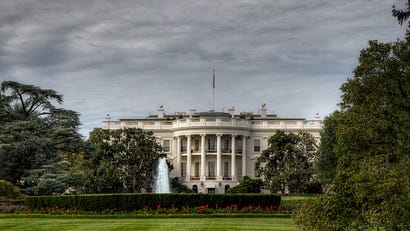You’re reading the My News Biz newsletter, which I will be sending you every other Thursday. My goal is to help you and other digital media entrepreneurs to find a viable business model that works for you. If you were forwarded this email, you can sign up here. You’re reading the Your News Biz newsletter. My goal is to help digital media entrepreneurs find viable business models.
Future of local news: nonprofit, collaboration, innovationAs community news continues to disappear under the pressure of economic decline and digital disruption, new models and coalitions are emerging to mend it. They’re focused on strategy, infrastructure, and collaboration. The audience of news media professionals at ISOJ25 were told they have to change. “You are a naturally competitive industry. You cannot be that going forward,” said Dale Anglin, director of Press Forward, a coalition of 90 funders managing a $500 million investment into local news across the U.S. Her message was clear: the path forward isn't about outpacing each other, but about working together. Press Forward’s approach is a "ground up" model that acknowledges the different needs and contexts of every American community. They see their role as strengthening local newsrooms, advancing public policy that expands access to local news, and “scaling the infrastructure the sector needs to thrive,” according to their website. Anglin was part of a panel that also included representatives from three other funds supporting nonprofit media: the American Journalism Project, the Brazilian Journalism Support Fund, and the International Fund for Public Interest Media. They described how they’re building a stronger news ecosystem — locally and globally. The panel was moderated by Jim Brady, vice president for journalism at the Knight Foundation. Sustainability, not dependenceSarabeth Berman, chief executive of the American Journalism Project, a venture fund investing in nonprofit local newsrooms, told the audience her organization is committed to not only financing but sustaining the future of local journalism. Berman said that the key to helping news organizations achieve long-term viability is empowering newsrooms with the infrastructure, technical tools, and public support they need to bring additional revenue. Since launching in 2019, the project has invested in 50 nonprofit news organizations in 36 states. Berman said the decline of local news is having real life consequences on local communities. The loss of local news is linked to declining voting rates and community polarization. Philanthropy offers a potential antidote, she said, by uniting communities around a cause and improving the quality of news content. A global fund tailored to local needsCollaboration was also a focus for Vanina Berghella, regional director for Latin America and the Caribbean for the International Fund for Public Interest Media. Since its launch in 2022, the fund has made $23 million in grants in 26 countries. Berghella said it’s important to consider the needs and experiences of locals rather than pursuing one-size-fits-all solutions. “We understand the difference between the country, the context, the needs of each media market and their audience,” Berghella said. In Brazil, collaborating beyond news media. Carolina Oms, director of partnerships and fundraising for the Brazilian Journalism Support Fund, said most investment is concentrated in southeastern Brazil, disproportionately the country’s richest region. In order to reach beyond that region, media need to collaborate with people skilled in technology.
+++++ Public media, often the only game in townThe public broadcasting system in the U.S. is once again under threat, as political pressure mounts to eliminate federal funding for National Public Radio (NPR) and the Public Broadcasting Service (PBS). At the heart of this debate lies a question with far-reaching implications: how much is public media really worth to a democracy? Speaking at ISOJ2025, NPR CEO Katherine Maher emphasized that cutting federal funding would do more than trim budgets — it would endanger the infrastructure that allows public media to serve rural America. NPR’s network includes 246 dues-paying member stations spanning all 50 states and Guam, collectively reaching 99.7% of the U.S. population. These stations contribute to a decentralized but unified system that supports over 200 local newsrooms. All these are part of the broader network of 1,300 public radio stations, which may pay for part or none of the programming of the big member stations. How much funding are we talking about?Federal funding for public media in the U.S. is distributed primarily through the Corporation for Public Broadcasting (CPB). In fiscal years 2022 and 2023, CPB received $475 million annually from Congress. That figure increased slightly to $525 million in 2024 and $535 million in 2025. For NPR, federal funding directly accounts for only about 1% of its $300 million annual budget — around $3 million per year. An additional $8 million goes to maintain the Public Radio Satellite System (PRSS), a crucial infrastructure that links more than 1,300 public radio stations across the country. That satellite system also supports components of the national emergency alert system. By contrast, PBS is more reliant on CPB funding, with federal dollars making up approximately 15% of its annual operating revenue. Much of this funding is funneled through local member stations, many of which are the only local news sources in their communities. The high cost of infrastructure“The cost of maintaining infrastructure in the high desert of the Southwest, in the hollers of Appalachia, in the valleys of our mountain systems, is extraordinarily high,” Maher said. “Infrastructure is not cheap.” She warned that eliminating federal support would hit smaller, rural stations the hardest — stations that often represent the only press presence in their communities. In fact, 20% of Americans have no access to a local news organization outside of public media. Without it, civic participation, voter engagement, and access to essential emergency broadcasting would be diminished, she said. Political pressures and cultural criticismFederal support for NPR and PBS has long been a political flashpoint. President Trump has urged Republicans in Congress to eliminate their funding. “Republicans, don’t miss this opportunity to rid our country of this giant SCAM, both being arms of the Radical Left Democrat Party.” An investigation launched by FCC Chairman Brendan Carr in early 2025 seeks to determine whether NPR and PBS have violated federal law by airing commercials. These criticisms were echoed in a congressional hearing Maher attended just days before the ISOJ conference, where she defended NPR’s editorial integrity and acknowledged past missteps — such as the outlet’s delayed coverage of the Hunter Biden laptop story. However, she added: “I want to start by just defending and standing up and advocating for our newsroom. We produce award-winning, extraordinarily strong journalism.” Yet public media can’t survive on good intentions alone. As Maher put it, “85% of Americans believe that local news matters. 15% of Americans are willing to pay for it.” That gap is precisely where public media — and by extension, federal support — plays a vital role. +++
The threat of a Trump recessionDick Tofel, former president of the ProPublica investigative journalism site, is warning that a Trump-induced recession would devastate local news organizations. Funders will be swamped with requests at the same time that their resources will be stretched: “aid to nonprofits, including nonprofit newsrooms, is likely to be limited, particularly from institutional foundations. “Those funders are already facing unprecedented demands across their portfolios from victims of and gaps left by Trump and Musk’s nihilism, including on public health, environmental issues, international development assistance, racial justice— and likely soon domestic public broadcasting.” He added, “Beyond those domestic concerns, cuts to US international public broadcasting and U.S. government aid to journalism internationally amount to a sum about 12 times the size of the entire Press Forward initiative, opening another enormous funding gap. Many grantors are also already worried about the possibility of increased taxation on income from their endowments.”
Fighting back. In a previous post, Tofel proposed a whole series of actions to take against the White House’s threats to press freedom: Thinking about collective action, as threats mount.Previously: Latin American media under fire, and Trump mimics their persecutors You're currently a free subscriber to Your News Biz. For the full experience, upgrade your subscription. |
EL PERIÓDICO DE LOS PERIÓDICOS. SOMOS NOTICIAS. Para publicar, contactar: aliazon.comercialyventas@gmail.com
Páginas
- Inicio
- NACIONAL ESPAÑA
- INTERNACIONAL
- BOLETINES DIARIOS
- PORTADAS
- SOCIEDAD
- POLÍTICA
- SECCIONES
- ARTÍCULOS
- ECONOMÍA
- CULTURA
- NOTICIAS TURISMO
- PERIODISTAS
- REVISTAS
- NOTICIERO
- HEMEROTECAS
- REDES SOCIALES
- EVENTOS
- CLIMA
- PUBLICIDAD
- MENÚ
- COMUNICADOS DE PRENSA
- BOLETINES INFORMATIVOS
- MUNDO RURAL
- FEMINISMO
- GASTRONOMÍA
- EMPRESAS
- EL TIEMPO
- RADIO Y TELEVISIÓN
- CIENCIA
- MOTOR
- CONSUMO
- EDUCACIÓN
- TOROS
- OPINIÓN
- BLOGS
- ELECCIONES
- PODCASTS
- PASATIEMPOS
- NEWSLETTERS
- EMPLEO
- SERVICIOS
- SALUD
- ARTE
- BELLEZA
- LIBROS
- NEGOCIOS
- MEDIO AMBIENTE
- TECNOLOGÍA
- LOTERÍAS Y JUEGOS
- MODA
- OTROS
- HORÓSCOPO
- LIFESTYLE
jueves, 1 de mayo de 2025
Local news finds some lifelines
Suscribirse a:
Enviar comentarios (Atom)
ARTÍCULOS
¿Tienes información sobre alguna noticia interesante? aliazon.comercialyventas@gmail.com
ROPA Y COMPLEMENTOS ALIAZON
ROPA Y COMPLEMENTOS
OPINIÓN

Opinión y análisis // Diariocrítico.com
Artículos de Opinión | El Independiente
RSS de noticias de opinion
OPINION EL CONFIDENCIAL
Estrella Digital :: Últimas opiniones
Nuevatribuna :: Últimas opiniones
OPINIÓN-KHAMENEI
ÚLTIMAS NOTICIAS

ÚLTIMAS NOTICIAS
Últimas noticias // Diariocrítico.com
Estrella Digital :: Últimas noticias
Comentarios en: Últimas noticias
RSS de noticias de ultima-hora
PORTADAS
RSS de noticias de portada
NACIONAL ESPAÑA

Noticias nacionales | Diariocritico // Diariocrítico.com
MUNDO-KHAMENEI
CULTURA
ARTE
Arte y Cultura // Diariocrítico.com
TEATRO
Salud y vida saludable // Diariocrítico.com
SEXUALIDAD
Sexualidad y salud sexual y para disfrutar de las relaciones en pareja // Diariocrítico.com
SALUD
HISTORIA
Canal Historia // Diariocrítico.com
TURISMO
SOCIEDAD

Sociedad EL CONFIDENCIAL
LIFESTYLE
Estilo Hombre
MODA
CRÓNICA ROSA
Noticias del Corazón // Diariocrítico.com
LO MÁS LEÍDO
Lo más leido de la semana // Diariocrítico.com
CIENCIA
LIBROS
Noticias de libros, editoriales, autores y premios literarios // Diariocrítico.com
ECONOMÍA

Economía-EL CONFIDENCIAL
La actualidad económica en vivo - France 24
RSS de noticias de economia
COMENTARIOS DE ECONOMÍA
Comentarios de la Economía // Diariocrítico.com
Noticias economicas | Diariocritico // Diariocrítico.com
MERCADOS

Mercados - EL CONFIDENCIAL
EMPRESAS

Empresas - EL CONFIDENCIAL
FINANZAS








No hay comentarios:
Publicar un comentario